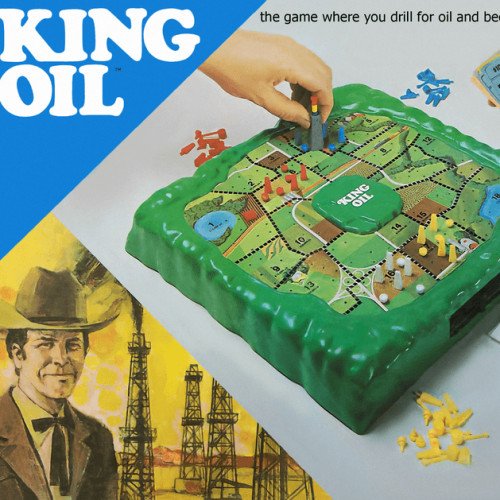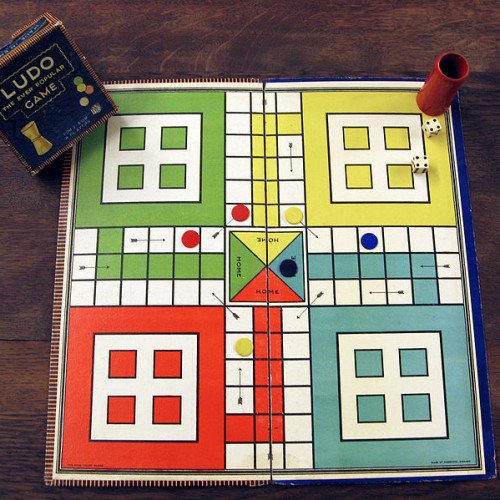"KING OIL" vs "LUDO"

KING OIL
King Oil is a board game by Scott Patton, created in 1974 and now long out-of-print. The game requires players to drill for oil on a three-dimensional board, acquiring property and wealth. The board is "randomized" using three rotating discs, hidden inside the plastic frame of the game and containing varying hole locations; one player turns at least one of the discs before play begins. There are 1,728 (12³, or 12x12x12) permutations of oil wells. The rotating discs determine the depth of the wells that players will drill, with four possibilities: shallow depth (the "driller" passes through no holes, showing all three colors) medium depth (passes through one hole, showing two colors) deep depth (passes through two holes, showing one color) dry hole (passes through all three holes, showing no colors) At least two color schemes are used for the driller (depending on the edition), using red, yellow, and blue, in either order. A player pays $2,000, $4,000, or $6,000 to drill each well, depending on depth (the deeper the depth the more it costs; the last amount also applies to "dry" holes). Before drilling, players must buy property. (Each player choose one of 18 properties on the board to begin the game.) Pipelines can be bought once there are four producing oil wells on a property. The pipelines span into adjacent properties, enabling the pipeline owner to siphon royalties from the adjacent property owner every turn. This game mechanic accelerates bankruptcy of opposing players, keeping total playing time within reasonable limits. The goal of the game is to push all opponents into bankruptcy; the last remaining player is the winner. The game can also end if the bank runs out of money; in this case, the remaining players total up their assets and the player with the highest net worth is the winner. The game is played by two to four players. The game includes one playing surface, one oil well Rig "driller", 84 derricks (21 per color), 128 well caps (32 per color), 24 tool sheds (6 per color), 36 pipelines (9 per color), (Each of these items are in four different colors: Red, Blue, White, Yellow), 1 money pack (50 of each bill: $500 (Yellow color), $1000 (Pink color), $5000 (Green color), and $10,000 (Blue color) and 32 "King Oil"* turn cards (some editions of the game label the turn cards "Wildcat").
Statistics for this Xoptio

LUDO
Ludo (/ˈljuːdoʊ/; from Latin ludo 'I play') is a strategy board game for two to four players, in which the players race their four tokens from start to finish according to the rolls of a single die. Like other cross and circle games, Ludo is derived from the Indian game Pachisi, but simpler. The game and its variations are popular in many countries and under various names. Pachisi was created in India in the 6th century. The earliest evidence of this game's evolution in India is the depiction of boards on the caves of Ellora. The original version is also described in Indian epic Mahabharata in which Shakuni uses the cursed dice to beat the Pandavas and at last after losing everything, Yudhisthira puts his wife Draupadi on stake and loses her too. However, Pandavas get all their belongings back after Draupadi vows to curse the whole Kuru lineage but stops at the intervention of Gandhari and seeing an opportunity to vent Draupadi's anger, Kuru king Dhritarashtra promises to give back the Pandavas, all that they had lost in the game. It was also known as Chaupar in ancient times. The contemporary version was played by the Mughal emperors of India; a notable example is Akbar. Pachisi was modified to use a cubic die with dice cup and patented as "Ludo" in England in 1896. The Royal Navy took Ludo and converted it into the board game Uckers. Special areas of the Ludo board are typically coloured bright yellow, green, red, and blue. Each player is assigned a colour and has four tokens in their colour. The board is normally square with a cross-shaped playspace, with each arm of the cross having three columns of squares, usually six per column. The middle columns usually have five squares coloured; these represent a player's home column. A sixth coloured square not on the home column is a player's starting square. At the centre of the board is a large finishing square, often composed of coloured triangles atop the players' home columns (thus depicting "arrows" pointing to the finish).